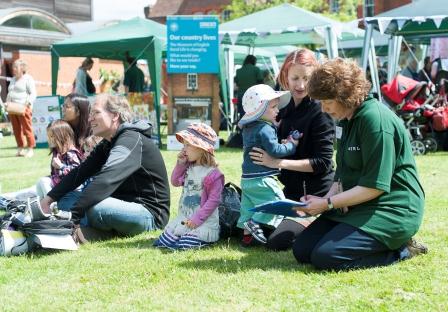Written by Phillippa Heath, Audience Development Project Manager
One important aspect of the Our Country Lives Activity Plan is the strengthening of links with our close neighbours the Royal Berkshire Hospital. As our Audience Development Project Manager, I’ve been involved in one particular aspect of this partnership: an innovative reminiscence project using the MERL collections as inspiration.
For a number of years the Royal Berkshire Hospital has been a regular destination for MERL staff on the search for lunches or mid-afternoon snacks from one of its many retail outlets. Interestingly, visitor evaluation of the museum before our closure suggested that this flow of people was reciprocated, with roughly 10% of our visitors coming from the Hospital. The Our Country Lives project is enabling us to formalise this relationship and explore what more can be done to raise awareness of the Museum for hospital patients, their families and hospital staff. The first part of this process has been a collaboration with patients, staff and volunteers of the Hospital’s Elderly Care Ward.
Initial conversations with staff over the Summer months quickly revealed an enthusiasm to use the MERL collections as a basis for reminiscence with patients. Reminiscence (or the use of life histories – written, oral, or both – to improve psychological well-being) is proven to have particular benefit for older people. Lyndsey Openshaw, Hospital Therapist and Manager of the Care Crew team, explains the benefits of reminiscence for this audience in more detail:
“Using physical objects and pictures to encourage older people, and those with dementia, to talk about old memories, is a wonderful way to bring back happy memories. It also helps us to facilitate conversations with the patients – which is hugely beneficial in their recovery, as some older people feel lonely.”
Formally launched in October, the project is inspired by one of the Museum’s new galleries: A Year on the Farm. A programme of fortnightly sessions has been devised, exploring different topics relating to a year in the countryside. With topics as diverse as Harvest, Sports and Pastimes and Gardening and Growing, sessions draw on the museum’s extensive film and photographic archive, using them as a starting point for conversations with patients.
The sessions are delivered jointly with hospital Chaplain Lorraine Colam, and frequently involve sensory experiences appropriate to the topic such as music, food, drink and handling opportunities. Many of the topics relate to activities or events which patients may have experienced in their lifetime, be they from rural or urban backgrounds. It is fascinating to hear so many different stories in relation the topics and, from the Museum’s point of view, it tells us so much about our collections and the public’s reactions to them.
Our most recent session focused on ‘Sports and Pastimes’, during which we watched the 1944 archive film, Twenty Four Square Miles. This film focused on the life of people living in one part of rural Oxfordshire and proved to be a great stimulus for memories. Photographs also resulted in some fascinating discussions (examples of which can be found below) .
Sessions will be continuing throughout the year, during which we are looking forward to many more fascinating conversations with patients and staff of the Royal Berkshire Hospital.







